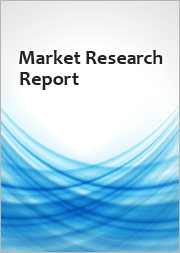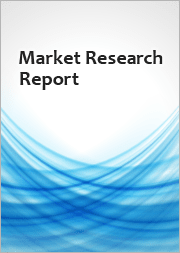
|
시장보고서
상품코드
1576454
세계의 증강현실(AR) 시장 규모, 점유율, 예측 및 동향 분석 : 제품, 유형, 용도, 최종사용자, 지역별 - 예측(-2031년)Augmented Reality Market Size, Share, Forecast, & Trends Analysis by Offering, Type, Application, End User, and Geography - Global Forecast to 2031 |
||||||
이 보고서는 세계 증강현실(AR) 시장(2031년까지)에 대해 조사 분석했으며, 주요 5개 지역의 증강현실(AR) 시장을 상세하게 분석했으며, 현재 시장 동향, 시장 규모, 시장 점유율, 최근 동향, 2031년까지의 예측 등에 대해 조사하여 전해드립니다.
증강현실(AR) 시장은 2024년부터 2031년까지 연평균 복합 성장률(CAGR) 34.9%로 2031년까지 2,101억 달러에 달할 것으로 예상됩니다.
AR 도입을 위한 정부 이니셔티브 증가, 소매 및 전자상거래 분야에서의 AR 기술 수요 증가, 의료 분야에서의 AR 기술 도입 확대가 이 시장의 성장을 견인하고 있습니다. 그러나 프라이버시 및 보안에 대한 우려와 높은 하드웨어 비용이 시장 성장을 저해하는 요인으로 작용하고 있습니다.
또한, 5G 기술의 발전과 여행 및 관광 산업의 새로운 비즈니스 기회는 시장 성장의 기회를 창출할 것으로 예상됩니다. 그러나 숙련된 전문가 부족은 시장 성장에 영향을 미치는 중요한 과제입니다.
목차
제1장 시장 정의와 범위
제2장 조사 방법
- 조사 접근
- 데이터 수집과 검증 프로세스
- 2차 조사
- 1차 조사/업계 KOL에의 인터뷰
- 시장 규모와 예측
- 시장 규모·추산 접근
- 성장 예측 접근
- 책 조사의 전제조건
제3장 주요 요약
- 개요
- 시장 분석 : 제공 내용별
- 시장 분석 : 유형별
- 시장 분석 : 용도별
- 시장 분석 : 최종 이용 산업별
- 시장 분석 : 지역별
- 경쟁 분석
제4장 시장 인사이트
- 시장 개요
- 시장 성장에 영향을 미치는 요인
- 성장 촉진요인
- 성장 억제요인
- 기회
- 과제
- 시장 동향
- 사례 연구
- Porter의 Five Forces 분석
- 규제 분석
제5장 증강현실(AR) 시장 평가 : 제공 내용별
- 개요
- 하드웨어
- 헤드 마운트 디스플레이(HMD)
- 스마트 글래스
- 헤드셋
- 기타 헤드 마운트 디스플레이(HMD)
- 헤드업 디스플레이(HUD)
- 헤드 마운트 디스플레이(HMD)
- 플랫폼
- 서비스
제6장 증강현실(AR) 시장 평가 : 유형별
- 개요
- 마커 기반 AR
- 마커리스 AR
제7장 증강현실(AR) 시장 평가 : 용도별
- 개요
- 트레이닝 및 학습
- 품질 검사
- 관광 및 방문객 체험
- 원격 지원
- 설계 및 모델링
- 게임
- 프로모션 및 광고
- 기타 용도
제8장 증강현실(AR) 시장 평가 : 최종 이용 산업별
- 개요
- 산업 및 제조업
- 의료
- 교육
- 소매업 및 E-Commerce
- 미디어 및 엔터테인먼트
- 운송 및 물류
- 자동차 산업
- 여행 및 관광업
- 부동산
- 판매 및 마케팅
- 기타 산업
제9장 증강현실(AR) 시장 : 지역별
- 개요
- 북미
- 미국
- 캐나다
- 유럽
- 독일
- 영국
- 프랑스
- 이탈리아
- 스페인
- 기타 유럽
- 아시아태평양
- 일본
- 중국
- 인도
- 한국
- 기타 아시아태평양
- 라틴아메리카
- 중동 및 아프리카
제10장 경쟁 분석
- 개요
- 주요 성장 전략
- 경쟁 벤치마킹
- 경쟁 대시보드
- 업계 리더
- 시장 차별화 요인
- 기존 기업
- 신규 기업
- 시장 점유율 분석
제11장 기업 개요
- Google LLC
- PTC, Inc.
- Seiko Epson Corporation
- Microsoft Corporation
- Samsung Electronics Co., Ltd.
- Apple Inc.
- NVIDIA Corporation
- Qualcomm Technologies, Inc.
- Magic Leap, Inc.
- Vuzix Corporation
- Lenovo
- Sony Corporation
- Meta Platform, Inc.
- Snap Inc.
- MAD Gaze
주 : 주요 5개사의 SWOT 분석을 제공 예정*
제12장 부록
LSH 24.11.11Augmented Reality Market by Offering (Smart Glasses, Headsets), Type, Application (Training & Learning, Gaming, Promotion & Advertising), End User (Retail & E-commerce, Media & Entertainment, Healthcare, Travel & Tourism), and Geography-Global Forecast to 2031
The research report titled 'Augmented Reality Market by Offering (Smart Glasses, Headsets), Type, Application (Training & Learning, Gaming, Promotion & Advertising), End User (Retail & E-commerce, Media & Entertainment, Healthcare, Travel & Tourism), and Geography-Global Forecast to 2031,' provides an in-depth analysis of augmented reality market in five major geographies and emphasizes on the current market trends, market sizes, market shares, recent developments, and forecasts till 2031.
The augmented reality market is projected to reach $210.1 billion by 2031, at a CAGR of 34.9% from 2024 to 2031.
The growth of this market is driven by the increasing government initiatives for AR implementation, rising demand for AR technology in the retail & e-commerce sectors, and growing adoption in healthcare. However, privacy & security concerns and the high cost of hardware restrain the market's growth.
Additionally, advancements in 5G technology and emerging opportunities in the travel & tourism industry are expected to create market growth opportunities. However, the shortage of skilled professionals is a significant challenge impacting the market's growth.
The augmented reality market is segmented by offering (hardware (head-mounted display (smart glasses, headsets, other head-mounted displays), head-up display), platform, services), type (marker-based AR, marker-less AR), application (training & learning, quality inspection, tourism & visitor experience, remote assistance, designing & modeling, gaming, promotion & advertising, other applications), and end-use industry (industrial & manufacturing, healthcare, education, retail & e-commerce, media & entertainment, transportation & logistics, automotive, travel & tourism, real estate, sales & marketing, other end-use industries). The study also evaluates industry competitors and analyzes the market at the regional and country levels.
Based on offering, the augmented reality market is segmented into hardware, platform, and services. In 2024, the hardware segment is expected to account for the largest share of over 55% of the augmented reality market. The large market share of this segment is attributed to the rising demand for AR technology in the retail & e-commerce sectors, the rapid growth in smartphone sales, and the development of AR smart glasses by market players. In addition, the benefits offered by the hardware segment, such as improved user experience, increased performance, accurate tracking and mapping, user-friendly interfaces, and data visualization, are contributing to the growth of this segment. Moreover, this segment is also projected to register the highest CAGR during the forecast period.
Based on type, the augmented reality market is segmented into marker-based AR and marker-less AR. In 2024, the marker-based AR segment is expected to account for the larger share of the augmented reality market. The large market share of this segment is attributed to advancements in remote assistance systems for navigation in the automotive and travel & tourism sectors and rising demand for AR technology in the entertainment industry. Moreover, the marker-based AR segment is projected to register the highest CAGR during the forecast period.
Based on application, the augmented reality market is segmented into training & learning, quality inspection, tourism & visitor experience, remote assistance, designing & modeling, gaming, promotion & advertising, and other applications. In 2024, the gaming segment is expected to account for the largest share of over 33% of the augmented reality market. However, the promotion & advertising segment is projected to register the highest CAGR during the period. This segment's growth is driven by the widespread use of smartphones and tablets equipped with AR capabilities, the rising need to enhance consumer engagement, and the growing significance of AR in marketing and communications departments.
Based on end-use industry, the augmented reality market is segmented into industrial & manufacturing, healthcare, education, retail & e-commerce, media & entertainment, transportation & logistics, automotive, travel & tourism, real estate, sales & marketing, and other end-use industries. In 2024, the media & entertainment segment is expected to account for the largest share of over 25% of the augmented reality market. However, the healthcare segment is projected to register the highest CAGR during the period. The growth of this segment is driven by the growing development of AR solutions specifically for surgical environments that can enhance precision and reduce risks, the rise of telehealth, and increasing government investment in healthcare institutions.
Based on geography, the augmented reality market is segmented into North America, Europe, Asia-Pacific, Latin America, and the Middle East & Africa. In 2024, North America is expected to account for the largest share of over 40.0% of the augmented reality market. The presence of prominent augmented reality players is expected to contribute to the high revenue share of this region. However, the market in Asia-Pacific is projected to record the highest CAGR of over 37.5% during the forecast period. The growth of this regional market can be attributed to the increasing government initiatives aimed at promoting the implementation of immersive technologies across various sectors, advancements in 5G technology, and emerging opportunities in the travel & tourism industry. Moreover, the increasing growth of this regional market is attributed to the expansion of regional economies and rapid infrastructure development, particularly in Japan, South Korea, and India.
The key players operating in the augmented reality market are Google LLC (U.S.), PTC, Inc. (U.S.), Seiko Epson Corporation (Japan), Microsoft Corporation (U.S.), Samsung Electronics Co., Ltd. (South Korea), Apple Inc. (U.S.), NVIDIA Corporation (U.S.), Qualcomm Technologies, Inc. (U.S.), Magic Leap, Inc. (U.S.), Vuzix Corporation (U.S.), Lenovo (China), Sony Corporation (Japan), Meta Platform, Inc. (U.S.), Snap Inc. (U.S.), and MAD Gaze (China).
Key Questions Answered in the Report:
- Which are the high-growth market segments in terms of offering, type, application, and end-use industry?
- What is the historical market size for augmented reality across the globe?
- What are the market forecasts and estimates for 2024-2031?
- What are the major drivers, restraints, opportunities, challenges, and trends in the augmented reality market?
- Who are the major players in the augmented reality market, and what are their market shares?
- What is the competitive landscape like?
- What are the recent developments in the augmented reality market?
- What are the various strategies adopted by major market players?
- What are the geographic trends and high-growth countries?
- Who are the local emerging players in the augmented reality market? How do they compete with the other players?
Scope of the Report:
Augmented Reality Market Assessment-by Offering
- Hardware
- Head-mounted Display
- Smart Glasses
- Headsets
- Other Head-mounted Displays
- Head-up Display
- Platform
- Services
Augmented Reality Market Assessment-by Type
- Marker-based AR
- Marker-less AR
Augmented Reality Market Assessment-by Application
- Training & Learning
- Quality Inspection
- Tourism & Visitor Experience
- Remote Assistance
- Designing & Modeling
- Gaming
- Promotion & Advertising
- Other Applications
Augmented Reality Market Assessment-by End-use Industry
- Industrial & Manufacturing
- Healthcare
- Education
- Retail & E-commerce
- Media & Entertainment
- Transportation & Logistics
- Automotive
- Travel & Tourism
- Real Estate
- Sales & Marketing
- Other End-use Industries
Augmented Reality Market Assessment-by Geography
- North America
- U.S.
- Canada
- Europe
- Germany
- U.K.
- France
- Italy
- Spain
- Rest of Europe
- Asia-Pacific
- Japan
- China
- India
- South Korea
- Rest of Asia-Pacific
- Latin America
- Middle East & Africa
TABLE OF CONTENTS
1. Market Definition & Scope
- 1.1. Market Definition
- 1.2. Currency & Limitations
- 1.2.1. Currency
- 1.2.2. Limitations
2. Research Methodology
- 2.1. Research Approach
- 2.2. Data Collection & Validation Process
- 2.2.1. Secondary Research
- 2.2.2. Primary Research/Interviews with Key Opinion Leaders from the Industry
- 2.3. Market Sizing and Forecasting
- 2.3.1. Market Size Estimation Approach
- 2.3.2. Growth Forecast Approach
- 2.4. Assumptions for the Study
3. Executive Summary
- 3.1. Overview
- 3.2. Market Analysis, By Offering
- 3.3. Market Analysis, By Type
- 3.4. Market Analysis, By Application
- 3.5. Market Analysis, By End-use Industry
- 3.6. Market Analysis, By Geography
- 3.7. Competitive Analysis
4. Market Insights
- 4.1. Overview
- 4.2. Factors Affecting Market Growth
- 4.2.1. Drivers
- 4.2.1.1. Increasing Government Initiatives for AR Implementation
- 4.2.1.2. Rising Demand for AR Technology in the Retail & E-Commerce Sectors
- 4.2.1.3. Rising Adoption of AR Technology in the Healthcare Sector
- 4.2.2. Restraints
- 4.2.2.1. Privacy & Security Concerns
- 4.2.2.2. High Cost of Hardware
- 4.2.3. Opportunities
- 4.2.3.1. Advancements in 5G Technology
- 4.2.3.2. Emerging Opportunities in the Travel & Tourism Industry
- 4.2.4. Challenges
- 4.2.4.1. Shortage of Skilled Professionals in the Field of Immersive Technologies
- 4.2.1. Drivers
- 4.3. Market Trends
- 4.4. Case Studies
- 4.5. Porter's Five Forces Analysis
- 4.5.1. Bargaining Power of Buyers
- 4.5.2. Bargaining Power of Suppliers
- 4.5.3. Threat of Substitutes
- 4.5.4. Threat of New Entrants
- 4.5.5. Degree of Competition
- 4.6. Regulatory Analysis
5. Augmented Reality Market Assessment-by Offering
- 5.1. Overview
- 5.2. Hardware
- 5.2.1. Head-mounted Display
- 5.2.1.1. Smart Glasses
- 5.2.1.2. Headsets
- 5.2.1.3. Other Head-mounted Displays
- 5.2.2. Head-up Display
- 5.2.1. Head-mounted Display
- 5.3. Platform
- 5.4. Services
6. Augmented Reality Market Assessment-by Type
- 6.1. Overview
- 6.2. Marker-based AR
- 6.3. Marker-less AR
7. Augmented Reality Market Assessment-by Application
- 7.1. Overview
- 7.2. Training & Learning
- 7.3. Quality Inspection
- 7.4. Tourism & Visitor Experiences
- 7.5. Remote Assistance
- 7.6. Designing & Modeling
- 7.7. Gaming
- 7.8. Promotion & Advertising
- 7.9. Other Applications
8. Augmented Reality Market Assessment-by End-use Industry
- 8.1. Overview
- 8.2. Industrial & Manufacturing
- 8.3. Healthcare
- 8.4. Education
- 8.5. Retail & E-commerce
- 8.6. Media & Entertainment
- 8.7. Transportation & Logistics
- 8.8. Automotive
- 8.9. Travel & Tourism
- 8.10. Real Estate
- 8.11. Sales & Marketing
- 8.12. Other End-use Industries
9. Augmented Reality Market-by Geography
- 9.1. Overview
- 9.2. North America
- 9.2.1. U.S.
- 9.2.2. Canada
- 9.3. Europe
- 9.3.1. Germany
- 9.3.2. U.K.
- 9.3.3. France
- 9.3.4. Italy
- 9.3.5. Spain
- 9.3.6. Rest of Europe
- 9.4. Asia-Pacific
- 9.4.1. Japan
- 9.4.2. China
- 9.4.3. India
- 9.4.4. South Korea
- 9.4.5. Rest of Asia-Pacific
- 9.5. Latin America
- 9.6. Middle East & Africa
10. Competition Analysis
- 10.1. Overview
- 10.2. Key Growth Strategies
- 10.3. Competitive Benchmarking
- 10.4. Competitive Dashboard
- 10.4.1. Industry Leaders
- 10.4.2. Market Differentiators
- 10.4.3. Vanguards
- 10.4.4. Emerging Companies
- 10.5. Market Share Analysis
11. Company Profiles
- 11.1. Google LLC
- 11.2. PTC, Inc.
- 11.3. Seiko Epson Corporation
- 11.4. Microsoft Corporation
- 11.5. Samsung Electronics Co., Ltd.
- 11.6. Apple Inc.
- 11.7. NVIDIA Corporation
- 11.8. Qualcomm Technologies, Inc.
- 11.9. Magic Leap, Inc.
- 11.10. Vuzix Corporation
- 11.11. Lenovo
- 11.12. Sony Corporation
- 11.13. Meta Platform, Inc.
- 11.14. Snap Inc.
- 11.15. MAD Gaze
Note: SWOT Analysis of the Top 5 Companies Will Be Provided*
12. Appendix
- 12.1. Available Customization
- 12.2. Related Reports



















